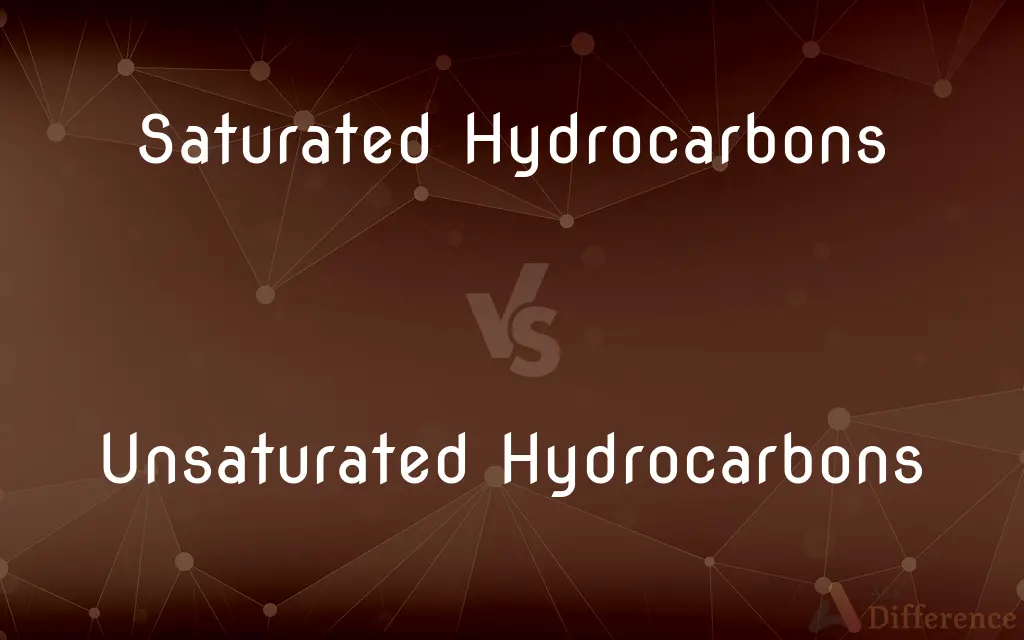Saturated Hydrocarbons vs. Unsaturated Hydrocarbons — What's the Difference?
By Tayyaba Rehman — Published on December 16, 2023
Saturated hydrocarbons have only single bonds, while unsaturated hydrocarbons contain at least one double or triple bond between carbon atoms.

Difference Between Saturated Hydrocarbons and Unsaturated Hydrocarbons
Table of Contents
ADVERTISEMENT
Key Differences
Saturated hydrocarbons and unsaturated hydrocarbons are classifications within organic compounds, primarily differentiated by the type of bonds they exhibit. Their chemical structures and reactions they undergo are distinctive because of these bond differences.
Saturated hydrocarbons, also termed alkanes, exclusively have single covalent bonds between carbon atoms. Each carbon atom is bonded to the maximum number of hydrogen atoms possible, making it "saturated" with hydrogen. Unsaturated hydrocarbons, on the other hand, have one or more double or triple bonds between carbon atoms, leading to fewer hydrogen atoms compared to their saturated counterparts.
The presence of double or triple bonds in unsaturated hydrocarbons introduces the potential for certain chemical reactions, like additions, which aren't typically observed in saturated hydrocarbons. The saturation level can affect the molecule's reactivity and properties.
Physical properties also differ between saturated hydrocarbons and unsaturated hydrocarbons. Generally, saturated compounds tend to have higher melting and boiling points. Unsaturated hydrocarbons, due to the double or triple bonds, can display cis-trans isomerism, providing geometric structural varieties.
In practical applications, saturated hydrocarbons are found in saturated fats and are typically solids at room temperature. In contrast, unsaturated hydrocarbons are present in oils and are usually liquids, contributing to their varied roles in industries and biological systems.
ADVERTISEMENT
Comparison Chart
Type of Bonds
Only single bonds
At least one double or triple bond
Hydrogen Count
Maximum possible
Reduced due to double/triple bonds
Reactivity
Generally less reactive
More reactive due to presence of pi bonds
Physical State
Often solid at room temperature (e.g., fats)
Often liquid at room temperature (e.g., oils)
Isomerism
Limited
Can exhibit cis-trans isomerism due to double bonds
Compare with Definitions
Saturated Hydrocarbons
Alkanes by another name.
Paraffin wax consists of saturated hydrocarbons.
Unsaturated Hydrocarbons
More reactive than their saturated counterparts.
The double bond in unsaturated hydrocarbons allows for polymerization.
Saturated Hydrocarbons
Present in saturated fats.
Butter, rich in saturated hydrocarbons, remains solid at room temperature.
Unsaturated Hydrocarbons
Organic compounds having fewer hydrogens due to multiple bonds.
Acetylene, used in welding, is an unsaturated hydrocarbon with a triple bond.
Saturated Hydrocarbons
Organic compounds with only single covalent bonds.
Methane is the simplest of all saturated hydrocarbons.
Unsaturated Hydrocarbons
Hydrocarbons with double or triple carbon-carbon bonds.
Ethylene is an unsaturated hydrocarbon with a double bond.
Saturated Hydrocarbons
Less reactive hydrocarbon class.
Saturated hydrocarbons like ethane don't readily form polymers.
Unsaturated Hydrocarbons
Include classes like alkenes and alkynes.
Oleic acid is an unsaturated hydrocarbon present in olive oil.
Saturated Hydrocarbons
Hydrocarbons saturated with the maximum number of hydrogens.
Propane, used in BBQ grills, is a saturated hydrocarbon.
Unsaturated Hydrocarbons
Exhibit cis-trans isomerism.
Some unsaturated hydrocarbons in margarine can be in trans configuration.
Common Curiosities
Which is more reactive, Saturated or Unsaturated Hydrocarbons?
Unsaturated Hydrocarbons are generally more reactive.
What are Saturated Hydrocarbons?
They are hydrocarbons with only single covalent bonds between carbon atoms.
Where are Saturated Hydrocarbons commonly found?
In saturated fats and waxes.
How do Unsaturated Hydrocarbons differ?
Unsaturated Hydrocarbons have one or more double or triple bonds.
Do Saturated Hydrocarbons exhibit cis-trans isomerism?
No, that property is seen in Unsaturated Hydrocarbons with double bonds.
Which type of hydrocarbon can form polymers easily?
Unsaturated Hydrocarbons due to their reactive double or triple bonds.
How do the physical properties of the two differ?
Saturated Hydrocarbons are generally solid and have higher melting points, while Unsaturated Hydrocarbons are often liquids.
Which hydrocarbon type is more prevalent in our diets?
Both types are present, but excessive Saturated Hydrocarbons can be less healthy.
What are the categories of Unsaturated Hydrocarbons?
Alkenes (double bond) and alkynes (triple bond).
What about the occurrence of Unsaturated Hydrocarbons?
They're found in oils and certain industrial chemicals.
Which has a higher melting point, Saturated or Unsaturated Hydrocarbons?
Saturated Hydrocarbons typically have higher melting points.
Can Unsaturated Hydrocarbons be converted to Saturated ones?
Yes, through hydrogenation.
Is "alkane" synonymous with Saturated Hydrocarbons?
Yes, alkanes are Saturated Hydrocarbons.
Can the structure of Unsaturated Hydrocarbons vary based on bond arrangement?
Yes, they can exhibit cis-trans isomerism due to double bonds.
Are Unsaturated Hydrocarbons usually solid or liquid?
They are usually liquids, like oils.
Share Your Discovery

Previous Comparison
Goals vs. Objectives
Next Comparison
Meso vs. EnantiomersAuthor Spotlight
Written by
Tayyaba RehmanTayyaba Rehman is a distinguished writer, currently serving as a primary contributor to askdifference.com. As a researcher in semantics and etymology, Tayyaba's passion for the complexity of languages and their distinctions has found a perfect home on the platform. Tayyaba delves into the intricacies of language, distinguishing between commonly confused words and phrases, thereby providing clarity for readers worldwide.
















































